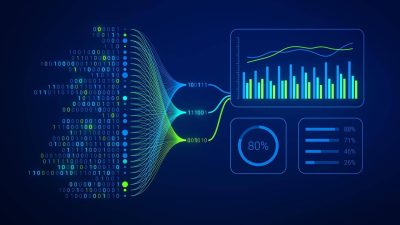The role of API integration in data visualization
In order to create an effective data visualization, it is essential to have access to accurate and timely data. This data can come from a variety of sources, but it is often most efficient to use an API to gather the information required.
An API, or application programming interface, is a set of rules that dictate how one software program can interact with another. You can create a more comprehensive and accurate data visualization by using an API to integrate data from different sources.
In addition to providing access to data, APIs also provide a way to control the data that’s actually pulled into your BI tool. Using an API to integrate data into your visualization, you can ensure that the information is displayed in the most effective way possible.
This can be especially important when working with large datasets, which can be challenging to visualize in their entirety.
API integration is an essential tool for creating compelling data visualizations. By using an API to access data from different sources and control the content of that data, you can create a more comprehensive and accurate visualization.
In this article, we will discuss the role of API integration in data visualization. We will also provide a few examples of how API integration can be used to create more effective data visualizations.

What is an API?
Before you can successfully integrate an API into your data visualization, it is important to understand what an API is and how it works.
An API is a set of rules that dictate how one software program can interact with another. In the context of data visualization, this means that you can use an API to access data from different sources and control exactly what data is transmitted.
In BI, an API can be used to access data from a variety of sources, including databases, applications, and web services. This data can then be integrated into your data visualization.
This means that companies that want to use data visualization to make better business decisions can do so without having to worry about the technical details of how to access and format data.
Why use an API for data visualization?
There are many reasons why you would want to use an API for data visualization. From a technical perspective, using an API can simplify the process of accessing and formatting data. This is because you can use the API to access data from multiple sources and then integrate that data into your visualization.
Here are a few more benefits of using an API for data visualization:
1. Access to more data
Imagine that you want to create a data visualization that shows your company’s sales over time. If you only have access to data from your own sales reports, then you will only be able to see sales data for your company.
However, if you use an API to access data from other sources, such as market research firms or social media platforms, then you will be able to include that data in your visualization. This can give you a more complete picture of your company’s sales.
2. Greater control over the data
When you use an API to access data, you have more control over what sort of data you actually access. For example, if you want to create a visualization that only shows data from certain regions or only includes data from certain time periods, you can use the API to filter the data accordingly.
This way, when a user needs to build a visualization, they know that the data that they have is the data that they need. They don’t need to sort through dozens or hundreds of different data sets to find the ones they need.

3. Increased accuracy for data visualizations
API integration can also help to ensure that your data visualizations are more accurate. This is because you can use the API to access data from multiple sources and then compare that data. This can help identify data errors or discrepancies between different sources.
4. Improved performance for data visualizations and BI tools
Another benefit of using an API for data visualization is that it can improve the performance of your data visualizations and BI tools. This is because the process of accessing and formatting data can be streamlined when you use an API.
5. Easy to share data visualizations
Finally, using an API can make it easier to share your data visualizations with others. This is because the data that is used to create the visualization can be stored in a central location, such as an API server. Then, anyone who wants to view the visualization can simply access the data from the server.
How to use an API for data visualization
Now that we’ve discussed some of the benefits of using an API for data visualization, let’s take a look at how you can actually use an API to create data visualizations.
There are two ways that you can use an API for data visualization:
- Use an existing data visualization tool that supports API integration.
- Use a programming language to create a custom API.
Let’s take a closer look at each of these methods.
1. Use an existing data visualization tool that supports API integration
If you want to use an API for data visualization but don’t want to learn how to code, then you can use a data visualization tool that supports API integration. Many different data visualization tools offer API support, so you should be able to find one that meets your needs.
When looking for a data visualization tool that supports API integration, there are a few things to remember.
First, make sure that the tool offers support for the type of data that you want to visualize. For example, if you want to visualize social media data, then you will need to find a tool that offers an API for accessing social media data.
Second, ensure that the tool offers support for the type of API you want. For example, if you want to use a REST API, then you will need to find a tool that supports REST API integration.
Finally, ensure the tool is easy to use and provides good documentation. This is especially important if you’re new to data visualization.
2. Use a programming language to create a custom API
If you’re comfortable with coding, then you can use a programming language to create a custom API. This approach gives you the most control over your data visualization, but also requires more time and effort.
To create a custom data visualization, you will need to choose a programming language and make sure that the tool you want to connect to offers API support in that language.
Once you’ve found an appropriate API, you can use the API documentation to learn how to access and format the data. Then, you can use the programming language to create the data visualization.

Tips for using an API for data visualization
If you’re planning on using an API for data visualization, there are a few things to keep in mind. These tips will help you get the most out of your data visualizations.
1. Use multiple data sources
One of the benefits of using an API is that you can access data from multiple sources. This can be useful for creating more comprehensive data visualizations.
For example, if you’re visualizing social media data, you may want to use an API that provides access to multiple social media platforms. This way, you can include data from all of the major social media networks in your visualization.
2. Use filtration and aggregation
When using an API for data visualization, you can use filtration and aggregation to get the specific data that you need. This can be useful for creating more targeted data visualizations.
For example, if you’re visualizing social media data, you may want to use an API that provides data filtration and aggregation access. This way, you can filter the data by certain keywords or hashtags and aggregate the data by location or time period.
3. Use historical and real-time data
Another benefit of using an API is that you can access both historical and real-time data. This can be useful for creating data visualizations that show trends over time.
For example, if you’re visualizing sales data, you may want to use an API that provides access to data that offers both historical and real-time data. This way, you can create a data visualization that shows how sales have changed over time.
Invest in powerful BI for better decision-making
Regarding data visualization, API integration is a powerful tool that can help you create more comprehensive and accurate data visualizations.
If you’re looking for a robust API integration solution, then you should consider investing in a powerful business intelligence (BI) platform. Look for acloud-based BI platform that offers a wide range of features, including API integration.
BI tools allow users to connect to hundreds of data sources, including social media, marketing, sales, and financial data. A good BI tool should also offer a wide range of visualization tools, so you can create custom data visualizations that meet your specific needs.
Check out some related resources:

10 Looker Alternatives and Competitors in 2025

Guide to Data Pipeline Design: Steps and Patterns






